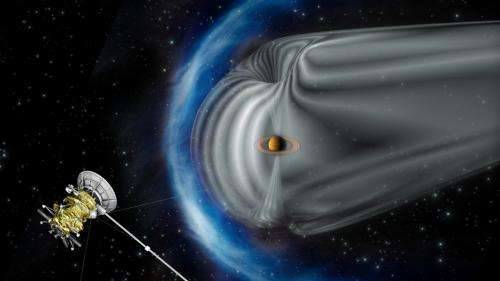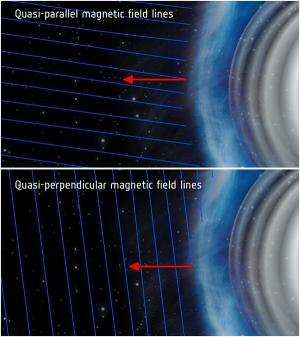Cassini sheds light on cosmic particle accelerators

(Phys.org)—During a chance encounter with what appears to be an unusually strong blast of solar wind at Saturn, NASA's Cassini spacecraft detected particles being accelerated to ultra-high energies. This is similar to the acceleration that takes place around distant supernovas.
Since we can't travel out to the far-off stellar explosions right now, the shockwave that forms from the flow of solar wind around Saturn's magnetic field provides a rare laboratory for scientists with the Cassini mission—a partnership involving NASA, the European Space Agency and the Italian Space Agency—to observe this phenomenon up-close. The findings, published this week in the journal Nature Physics, confirm that certain kinds of shocks can become considerably more effective electron accelerators than previously thought.
Shock waves are commonplace in the universe, for example in the aftermath of a stellar explosion as debris accelerate outward in a supernova remnant, or when the flow of particles from the sun - the solar wind - impinges on the magnetic field of a planet to form a bow shock. Under certain magnetic field orientations and depending on the strength of the shock, particles can be accelerated to close to the speed of light at these boundaries. These may be the dominant source of cosmic rays, high-energy particles that pervade our galaxy.

Scientists are particularly interested in "quasi-parallel" shocks, where the magnetic field and the "forward"-facing direction of the shock are almost aligned, as may be found in supernova remnants. The new study, led by Adam Masters of the Institute of Space and Astronautical Science, Sagamihara, Japan, describes the first detection of significant acceleration of electrons in a quasi-parallel shock at Saturn, coinciding with what may be the strongest shock ever encountered at the ringed planet.
"Cassini has essentially given us the capability of studying the nature of a supernova shock in situ in our own solar system, bridging the gap to distant high-energy astrophysical phenomena that are usually only studied remotely," said Masters.
Journal information: Nature Physics
Provided by JPL/NASA




















